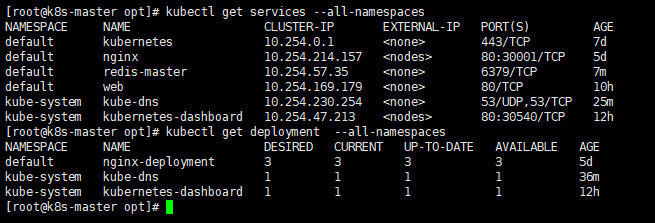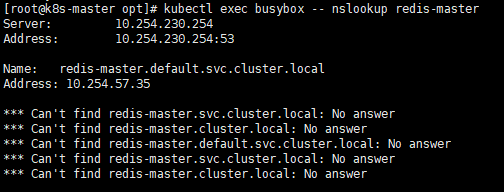Centos7 k8s dns
一、搭建dns
1、创建skydns-rc.yaml文件
[root@k8s-master opt]# vim skydns-rc.yaml # Copyright 2016 The Kubernetes Authors. # # Licensed under the Apache License, Version 2.0 (the "License"); # you may not use this file except in compliance with the License. # You may obtain a copy of the License at # # http://www.apache.org/licenses/LICENSE-2.0 # # Unless required by applicable law or agreed to in writing, software # distributed under the License is distributed on an "AS IS" BASIS, # WITHOUT WARRANTIES OR CONDITIONS OF ANY KIND, either express or implied. # See the License for the specific language governing permissions and # limitations under the License. # TODO - At some point, we need to rename all skydns-*.yaml.* files to kubedns-*.yaml.* # Should keep target in cluster/addons/dns-horizontal-autoscaler/dns-horizontal-autoscaler.yaml # in sync with this file. # __MACHINE_GENERATED_WARNING__ apiVersion: extensions/v1beta1 kind: Deployment metadata: name: kube-dns namespace: kube-system labels: k8s-app: kube-dns kubernetes.io/cluster-service: "true" spec: replicas: 1 # replicas: not specified here: # 1. In order to make Addon Manager do not reconcile this replicas parameter. # 2. Default is 1. # 3. Will be tuned in real time if DNS horizontal auto-scaling is turned on. strategy: rollingUpdate: maxSurge: 10% maxUnavailable: 0 selector: matchLabels: k8s-app: kube-dns template: metadata: labels: k8s-app: kube-dns annotations: scheduler.alpha.kubernetes.io/critical-pod: '' scheduler.alpha.kubernetes.io/tolerations: '[{"key":"CriticalAddonsOnly", "operator":"Exists"}]' spec: containers: - name: kubedns image: myhub.fdccloud.com/library/kubedns-amd64:1.9 resources: # TODO: Set memory limits when we've profiled the container for large # clusters, then set request = limit to keep this container in # guaranteed class. Currently, this container falls into the # "burstable" category so the kubelet doesn't backoff from restarting it. limits: memory: 170Mi requests: cpu: 100m memory: 70Mi livenessProbe: httpGet: path: /healthz-kubedns port: 8080 scheme: HTTP initialDelaySeconds: 60 timeoutSeconds: 5 successThreshold: 1 failureThreshold: 5 readinessProbe: httpGet: path: /readiness port: 8081 scheme: HTTP # we poll on pod startup for the Kubernetes master service and # only setup the /readiness HTTP server once that's available. initialDelaySeconds: 3 timeoutSeconds: 5 args: - --domain=cluster.local. - --dns-port=10053 - --config-map=kube-dns - --kube-master-url=http://192.168.125.130:8080 # This should be set to v=2 only after the new image (cut from 1.5) has # been released, otherwise we will flood the logs. - --v=0 #__PILLAR__FEDERATIONS__DOMAIN__MAP__ env: - name: PROMETHEUS_PORT value: "10055" ports: - containerPort: 10053 name: dns-local protocol: UDP - containerPort: 10053 name: dns-tcp-local protocol: TCP - containerPort: 10055 name: metrics protocol: TCP - name: dnsmasq image: myhub.fdccloud.com/library/kube-dnsmasq-amd64:1.4 livenessProbe: httpGet: path: /healthz-dnsmasq port: 8080 scheme: HTTP initialDelaySeconds: 60 timeoutSeconds: 5 successThreshold: 1 failureThreshold: 5 args: - --cache-size=1000 - --no-resolv - --server=127.0.0.1#10053 ports: - containerPort: 53 name: dns protocol: UDP - containerPort: 53 name: dns-tcp protocol: TCP # see: https://github.com/kubernetes/kubernetes/issues/29055 for details resources: requests: cpu: 150m memory: 10Mi - name: dnsmasq-metrics image: myhub.fdccloud.com/library/dnsmasq-metrics-amd64:1.0 livenessProbe: httpGet: path: /metrics port: 10054 scheme: HTTP initialDelaySeconds: 60 timeoutSeconds: 5 successThreshold: 1 failureThreshold: 5 args: - --v=2 - --logtostderr ports: - containerPort: 10054 name: metrics protocol: TCP resources: requests: memory: 10Mi - name: healthz image: myhub.fdccloud.com/library/exechealthz-amd64:1.2 resources: limits: memory: 50Mi requests: cpu: 10m # Note that this container shouldn't really need 50Mi of memory. The # limits are set higher than expected pending investigation on #29688. # The extra memory was stolen from the kubedns container to keep the # net memory requested by the pod constant. memory: 50Mi args: - --cmd=nslookup kubernetes.default.svc.cluster.local 127.0.0.1 >/dev/null - --url=/healthz-dnsmasq - --cmd=nslookup kubernetes.default.svc.cluster.local 127.0.0.1:10053 >/dev/null - --url=/healthz-kubedns - --port=8080 - --quiet ports: - containerPort: 8080 protocol: TCP dnsPolicy: Default
2、创建skydns-svc文件
[root@k8s-master opt]# vim skydns-svc.yaml # Copyright 2016 The Kubernetes Authors. # # Licensed under the Apache License, Version 2.0 (the "License"); # you may not use this file except in compliance with the License. # You may obtain a copy of the License at # # http://www.apache.org/licenses/LICENSE-2.0 # # Unless required by applicable law or agreed to in writing, software # distributed under the License is distributed on an "AS IS" BASIS, # WITHOUT WARRANTIES OR CONDITIONS OF ANY KIND, either express or implied. # See the License for the specific language governing permissions and # limitations under the License. # TODO - At some point, we need to rename all skydns-*.yaml.* files to kubedns-*.yaml.* # __MACHINE_GENERATED_WARNING__ apiVersion: v1 kind: Service metadata: name: kube-dns namespace: kube-system labels: k8s-app: kube-dns kubernetes.io/cluster-service: "true" kubernetes.io/name: "KubeDNS" spec: selector: k8s-app: kube-dns clusterIP: 10.254.230.254 ports: - name: dns port: 53 protocol: UDP - name: dns-tcp port: 53 protocol: TCP
3、创建
[root@k8s-master opt]# kubectl create -f skydns-rc.yaml
[root@k8s-master opt]# kubectl create -f skydns-svc.yaml
4、查看状态

5、 在k8s-node节点主要配置/etc/kubernetes/kubelet文件,添加参数配置KUBELET_ARGS如下:
[root@k8s-node1 ~]# vim /etc/kubernetes/kubelet ### # kubernetes kubelet (minion) config # The address for the info server to serve on (set to 0.0.0.0 or "" for all interfaces) KUBELET_ADDRESS="--address=0.0.0.0" # The port for the info server to serve on KUBELET_PORT="--port=10250" # You may leave this blank to use the actual hostname KUBELET_HOSTNAME="--hostname-override=k8s-node1" # location of the api-server KUBELET_API_SERVER="--api-servers=http://192.168.125.130:8080" # pod infrastructure container KUBELET_POD_INFRA_CONTAINER="--pod-infra-container-image=192.168.125.130:5000/pod-infrastructure:latest" # Add your own! KUBELET_ARGS="--cluster_dns=10.254.230.254 --cluster_domain=cluster.local" 添加这一行
6、node节点重启服务
[root@k8s-node1 ~]# systemctl restart kubelet.service
以上就完成了kubernetes的DNS配置,下面测试一下。
二、测试DNS
1.创建redis-master
[root@k8s-master opt]# vi redis.yaml apiVersion: v1 kind: Service metadata: name: redis-master labels: name: redis-master spec: selector: name: redis-master ports: - port: 6379 targetPort: 6379
2、启动redis
[root@k8s-master opt]# kubectl create -f redis.yaml service "redis-master" created
3.创建带有nslookup的busybox
[root@k8s-master yaml]# vi busybox.yaml apiVersion: v1 kind: Pod metadata: name: busybox namespace: default spec: containers: - image: docker.io/busybox command: - sleep - "3600" imagePullPolicy: IfNotPresent name: busybox restartPolicy: Always
4、启动busybox
[root@k8s-master opt]# kubectl create -f busybox.yaml pod "busybox" created
5、通过busybox执行nslookup看能否查找到redis-master

6、进入容器测试
[root@k8s-master opt]# kubectl get pods NAME READY STATUS RESTARTS AGE busybox 1/1 Running 0 17m nginx-deployment-3637952344-9cdgs 1/1 Running 2 5d nginx-deployment-3637952344-ntx44 1/1 Running 2 13h nginx-deployment-3637952344-shd6t 1/1 Running 2 5d [root@k8s-master opt]# kubectl exec -it busybox /bin/sh / # nslookup kubernnets.default.svc.cluster.local Server: 10.254.230.254 Address: 10.254.230.254:53



